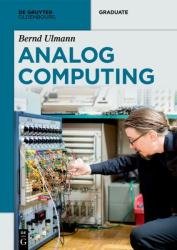Analog Computing, 2nd Edition
- Добавил: literator
- Дата: 29-10-2022, 15:51
- Комментариев: 0
 Название: Analog Computing, 2nd Edition
Название: Analog Computing, 2nd EditionАвтор: Bernd Ulmann
Издательство: De Gruyter
Год: 2023
Страниц: 460
Язык: английский
Формат: pdf (true)
Размер: 71.6 MB
The computing paradigm offered by analog computing is nearly forgotten, although it offers a path to both high-speed and low-power computing, which are in even more demand now than they were back in the heyday of electronic analog computers.This book provides a comprehensive introduction to analog computing. This second expanded edition contains the recent advancements of the last eight years.
A book on analog computing and analog computers? You might ask: Isn’t that 60 years late? No, it isn’t – although the beautiful analog computers of the past are long since history and only few have been preserved in museum collections, the idea of analog computing is still a marvel of elegance and the following chapters will show that it has a bright and fruitful future.
The intention of this book is twofold: It gives a comprehensive description of the history and technology of classic analog computing but also shows the particular strengths of the analog computation paradigm, which, combined with current state of the art digital circuitry, will find applications in areas such as low power computing, high performance computing and maybe most importantly in Artificial Intelligence (AI) and many other fields.
Programming an analog computer differs substantially from the algorithmic approach used for stored-program digital computers. Programming an analog computer can be considered being easier and maybe even more “natural” than developing and implementing an algorithm on a digital computer. This is especially true for engineers, physicists and mathematicians, since the analog computer is, due to its nature of forming an analog for a problem to be solved, closely related to their realms of expertise and their ways of thinking about complex dynamical systems.
From the perspective of a contemporary programmer, programming an analog computer will look like an arcane task, as it bears no resemblance at all to today’s ubiquitous algorithmic approach. Since analog computing is not part of the standard curriculum in a computer science class, programming such a machine is considered a curiosity while the much more abstract algorithmic approach has become natural.
Hybrid computers (analog computers coupled with stored-program digital computers) are covered in the Chapter 9. This is followed by a treatment of Digital Differential Analysers (digital implementations of analog computers), a chapter on stochastic computing, and a chapter on the simulation of analog computers on classic stored-program digital computers.
Скачать Analog Computing (De Gruyter Textbook), 2nd Edition
[related-news] [/related-news]
Внимание
Уважаемый посетитель, Вы зашли на сайт как незарегистрированный пользователь.
Мы рекомендуем Вам зарегистрироваться либо войти на сайт под своим именем.
Уважаемый посетитель, Вы зашли на сайт как незарегистрированный пользователь.
Мы рекомендуем Вам зарегистрироваться либо войти на сайт под своим именем.
